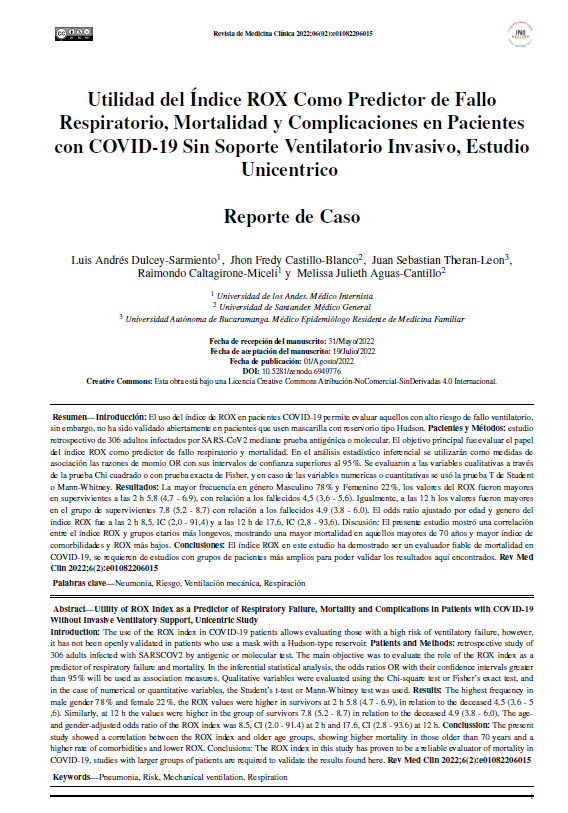Resumen
Introducción: El uso del índice de ROX en pacientes COVID-19 permite evaluar aquellos con alto riesgo de fallo ventilatorio, sin embargo, no ha sido validado abiertamente en pacientes que usen mascarilla con reservorio tipo Hudson. Pacientes y Métodos: estudio retrospectivo de 306 adultos infectados por SARS-CoV2 mediante prueba antigénica o molecular. El objetivo principal fue evaluar el papel del índice ROX como predictor de fallo respiratorio y mortalidad. En el análisis estadístico inferencial se utilizarán como medidas de asociación las razones de momio OR con sus intervalos de confianza superiores al 95%. Se evaluaron a las variables cualitativas a través de la prueba Chi cuadrado o con prueba exacta de Fisher, y en caso de las variables numericas o cuantitativas se usó la prueba T de Student o Mann-Whitney. Resultados: La mayor frecuencia en género Masculino 78% y Femenino 22%, los valores del ROX fueron mayores en supervivientes a las 2 h 5.8 (4.7 - 6.9), con relación a los fallecidos 4.5 (3.6 - 5.6). Igualmente, a las 12 h los valores fueron mayores en el grupo de supervivientes 7.8 (5.2 - 8.7) con relación a los fallecidos 4.9 (3.8 - 6.0). El odds ratio ajustado por edad y genero del índice ROX fue a las 2 h 8.5, IC (2.0 - 91.4) y a las 12 h de 17.6, IC (2.8 - 93.6). Conclusiones: El índice ROX ha demostrado ser un evaluador fiable de mortalidad en COVID-19, se requieren de estudios más amplios para validar los resultados aquí encontrados.
Referencias
Roca O, Messika J, et al. Predicting success of high-flow nasal cannula in pneumonia patients with hypoxemic respiratory failure: The utility of the ROX index. J Crit Care. 2016 Oct; 35:200-5. DOI: 10.1016/j.jcrc.2016.05.022.
Roca O, et al. An Index Combining Respiratory Rate and Oxygenation to Predict Outcome of Nasal High-Flow Therapy. Am J Respir Crit Care Med. 2019 Jun 1;199(11):1368-1376. DOI: 10.1164/rccm.201803-0589OC.
Chandel A, et al. High-Flow Nasal Cannula Therapy in COVID-19: Using the ROX Index to Predict Success. Respir Care. 2021 Jun;66(6):909-919. DOI: 10.4187/respcare.08631.
Goh KJ, et al. Early prediction of high flow nasal cannula therapy outcomes using a modified ROX index incorporating heart rate. J Intensive Care. 2020 Jun 22;8:41. DOI: 10.1186/s40560-020-00458-z.
Suliman LA, et al. Validity of ROX index in prediction of risk of intubation in patients with COVID-19 pneumonia. Adv Respir Med. 2021;89(1):1-7. DOI: 10.5603/ARM.a2020.0176.
Karim HMR, Esquinas AM. Success, or Failure of High-Flow Nasal Oxygen Therapy: The ROX Index Is Good, but a Modified ROX Index May Be Better. Am J Respir Crit Care Med. 2019 Jul 1;200(1):116-117. DOI: 10.1164/rccm.201902-0419LE.
Mauri T, et al. Increasing support by nasal high flow acutely modifies the ROX index in hypoxemic patients: A physiologic study. J Crit Care. 2019 Oct; 53:183-185. DOI: 10.1016/j.jcrc.2019.06.020.
Hill NS, et al. Predicting Outcomes of High-Flow Nasal Cannula for Acute Respiratory Distress Syndrome. An Index that ROX. Am J Respir Crit Care Med. 2019 Jun 1;199(11):1300-1302. DOI: 10.1164/rccm.201901-0079ED.
Lee CU, et al. The index of oxygenation to respiratory rate as a prognostic factor for mortality in Sepsis. Am J Emerg Med. 2020 Sep 24: S0735-6757(20)30849-4. DOI: 10.1016/j.ajem.2020.09.052.
Roca O, et al. An Index Combining Respiratory Rate and Oxygenation to Predict Outcome of Nasal High-Flow Therapy. Am J Respir Crit Care Med. 2019;199(11):1368-1376. DOI:10.1164/rccm.201803-0589OC.
Panadero C, et al. High-flow nasal cannula for Acute Respiratory Distress Syndrome (ARDS) due to COVID-19. Multidiscip Respir Med. 2020 Sep 16;15(1):693. DOI: 10.4081/mrm.2020.693.
Hu M, et al. Application of high-flow nasal cannula in hypoxemic patients with COVID-19: a retrospective cohort study. BMC Pulm Med. 2020 Dec 24;20(1):324. DOI: 10.1186/s12890-020-01354-w.
Chandel A., Patolia S., Brown A.W., Collins A.C., Sahjwani D., Khangoora V. High-flow nasal cannula in COVID-19: Outcomes of application and examination of the ROX index to predict success. Respir Care. 2020 Dec;66:909–919. DOI: 10.4187/respcare.08631.
Lambermont B., Davenne E., Maclot F., Delvenne P. SARS-CoV-2 in carotid body. Intensive Care Med. 2021;47:342–343. DOI: 10.1007/s00134-021-06351-z.
Gallo Marin B, Aghagoli G, Lavine K, Yang L, Siff EJ, Chiang SS, Salazar-Mather TP, Dumenco L, Savaria MC, Aung SN, Flanigan T, Michelow IC. Predictors of COVID-19 severity: A literature review. Rev Med Virol. 2021 Jan;31(1):1-10. doi: 10.1002/rmv.2146.

Esta obra está bajo una licencia internacional Creative Commons Atribución-NoComercial-SinDerivadas 4.0.
Derechos de autor 2022 Luis Andres Dulcey-Sarmiento, Jhon Fredy Castillo-Blanco, Juan Sebastián, Riamondo Caltagirone-Miceli, Melissa Julieth Aguas-Cantillo

